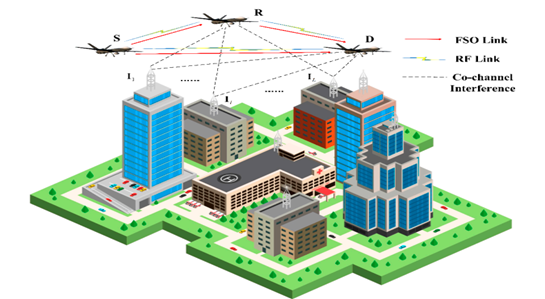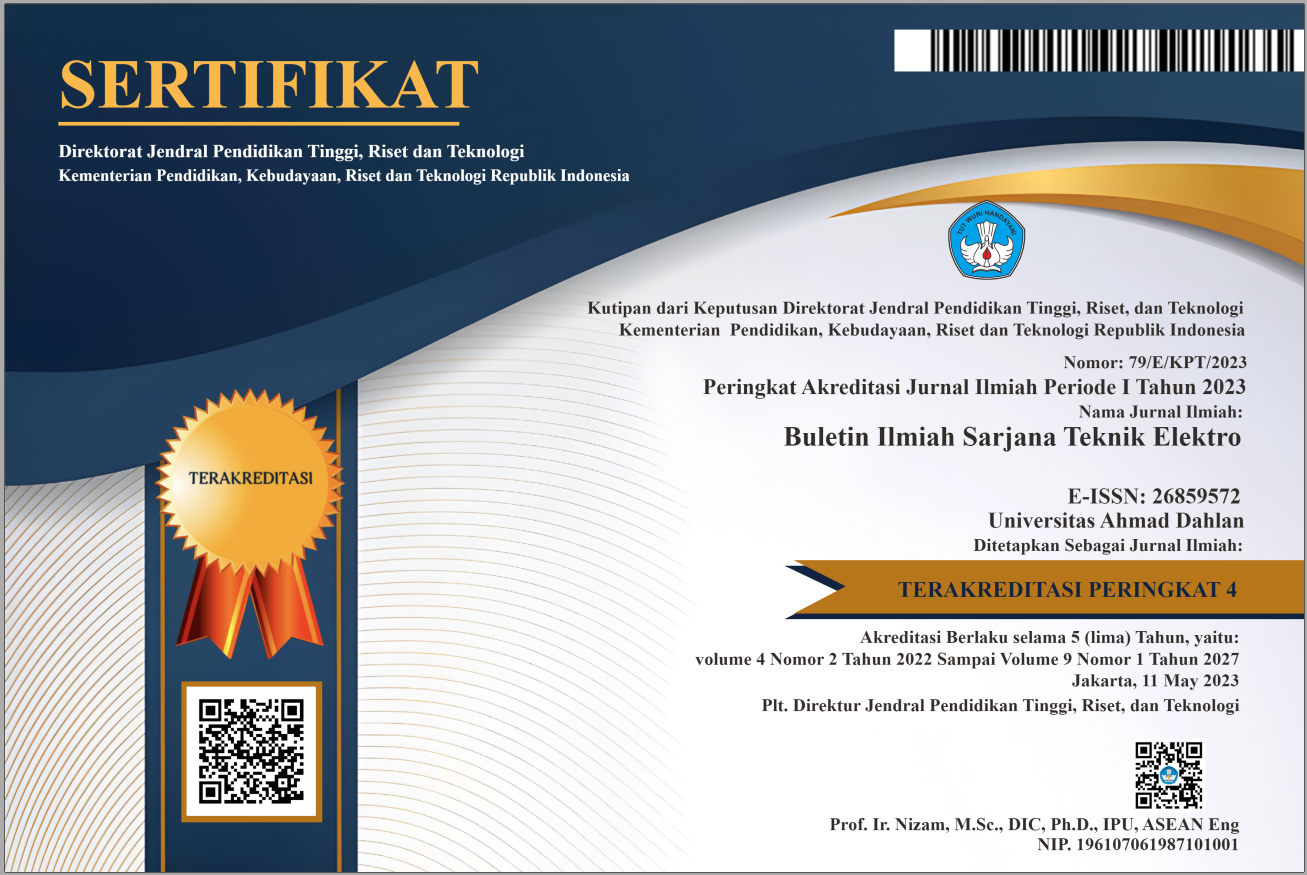An Analysis of UAV Security and Privacy Concerns of Communication Systems
DOI:
https://doi.org/10.12928/biste.v7i2.13057Keywords:
UAVs, Security, Fuzzy-logic Rules, Communication SystemAbstract
Wireless communication is one of the fastest-growing research fields, with Unmanned Aerial Vehicles (UAVs) increasingly deployed as mobile router points in high-traffic areas such as bus stations, metro stations, and airport terminals to address connectivity challenges. However, despite their utility, UAVs face significant security and privacy risks. This paper presents a comprehensive analysis of these vulnerabilities through a systematic four-level classification: sensor, communication, software, and hardware. For each level, we examine (1) common weaknesses exploitable by malicious actors, (2) potential threats to civilian UAV applications, (3) active and passive attacks compromising security and privacy, and (4) possible countermeasures to mitigate such risks. Additionally, we summarize key findings on UAV security and privacy issues and highlight critical unresolved challenges. Finally, we propose future research directions, including the use of fuzzy logic to optimize drone routing by dynamically relocating UAVs to low-activity zones based on fuzzy rule-based decisions.
References
S. Hayat, E. Yanmaz and R. Muzaffar, "Survey on Unmanned Aerial Vehicle Networks for Civil Applications: A Communications Viewpoint," in IEEE Communications Surveys & Tutorials, vol. 18, no. 4, pp. 2624-2661, 2016, https://doi.org/10.1109/COMST.2016.2560343.
L. Gupta, R. Jain and G. Vaszkun, "Survey of Important Issues in UAV Communication Networks," in IEEE Communications Surveys & Tutorials, vol. 18, no. 2, pp. 1123-1152, 2016, https://doi.org/10.1109/COMST.2015.2495297.
N. Hossein Motlagh, T. Taleb and O. Arouk, "Low-Altitude Unmanned Aerial Vehicles-Based Internet of Things Services: Comprehensive Survey and Future Perspectives," in IEEE Internet of Things Journal, vol. 3, no. 6, pp. 899-922, 2016, https://doi.org/10.1109/JIOT.2016.2612119.
R. Kellermann, T. Biehle, and L. Fischer, “Drones for parcel and passenger transportation: A literature review,” Transportation Research Interdisciplinary Perspectives, vol. 4, p. 100088, 3 2020, https://doi.org/10.1016/j.trip.2019.100088.
L. Kapustina, N. Izakova, E. Makovkina, E., & Khmelkov, M. (2021). The global drone market: main development trends. In SHS web of conferences, vol. 129, p. 11004, 2021, https://doi.org/10.1051/shsconf/202112911004.
R. Rodriguez, “Perspective: Agricultural aerial application with unmanned aircraft systems: Current regulatory framework and analysis of operators in the United States,” Transactions of the ASABE, vol. 64, no. 5, pp. 1475-1481, 2021, https://doi.org/10.13031/trans.14331.
Z. Liu, Z. Li, B. Liu, X. Fu, I. Raptis, and K. Ren, “Rise of MiniDrones,” in Proceedings of the 2015 Workshop on Privacy-Aware Mobile Computing, pp. 7–12, 2015, https://doi.org/10.1145/2757302.2757303.
[S. Park, H. T. Kim, S. Lee, H. Joo and H. Kim, "Survey on Anti-Drone Systems: Components, Designs, and Challenges," in IEEE Access, vol. 9, pp. 42635-42659, 2021, https://doi.org/10.1109/ACCESS.2021.3065926.
H. Sedjelmaci, S. M. Senouci and M. -A. Messous, "How to Detect Cyber-Attacks in Unmanned Aerial Vehicles Network?," 2016 IEEE Global Communications Conference (GLOBECOM), pp. 1-6, 2016, https://doi.org/10.1109/GLOCOM.2016.7841878.
E. Barka, C. A. Kerrache, N. Lagraa, A. Lakas, C. T. Calafate, J. C. Cano, UNION: a trust model distinguishing intentional and UNIntentional misbehavior in inter‐UAV communication. Journal of advanced transportation, vol. 2018, no. 1, p. 7475357, 2018, https://doi.org/10.1155/2018/7475357.
R. Ganesan, X. M. Raajini, A. Nayyar, P. Sanjeevi kumar, E. Hossain, and A. H. Ertas, “Bold: Bio-inspired optimized leader election for multiple drones,” Sensors, vol. 20, no. 11, p. 3134, 2020, https://doi.org/10.3390/s20113134.
X. Du, Y. Li, S. Zhou, and Y. Zhou, “ATS-LIA: A lightweight mutual authentication based on adaptive trust strategy in flying ad-hoc networks, peer-to-peer Netw,” Appl., vol. 15, no. 4, pp. 1979–1993, 2022, https://doi.org/10.1007/s12083-022-01330-7.
V. Bhardwaj, N. Kaur, S. Vashisht, and S. Jain, “SecRIP: secure and reliable intercluster routing protocol for efficient data transmission in flying ad hoc networksTrans,” Emerg. Telecommun. Technol., vol. 32, no. 6, 2021, https://doi.org/10.1002/ett.4068.
C. F. E. de Melo et al., "UAVouch: A Secure Identity and Location Validation Scheme for UAV-Networks," in IEEE Access, vol. 9, pp. 82930-82946, 2021, https://doi.org/10.1109/ACCESS.2021.3087084.
Y. Wang et al., "CATrust: Context-Aware Trust Management for Service-Oriented Ad Hoc Networks," in IEEE Transactions on Services Computing, vol. 11, no. 6, pp. 908-921, 2018, https://doi.org/10.1109/TSC.2016.2587259.
M. Hosseinzadeh, et al., “An energy-aware routing scheme based on a virtual relay tunnel in flying ad hoc networks,” Alexandria Engineering Journal, vol. 91, pp. 249-260, 2024, https://doi.org/10.1016/j.aej.2024.02.006.
S. Yu, J. Lee, A. K. Sutrala, A. K. Das, and Y. Park, “LAKA-UAV: lightweight authentication and key agreement scheme for cloud-assisted unmanned aerial vehicle using blockchain in flying ad-hoc networks,” Comput. Netw., vol. 224, p. 109612, 2023, https://doi.org/10.1016/j.comnet.2023.109612.
A. M. Rahmani, S. Ali, E. Yousefpoor, M. S. Yousefpoor, D. Javaheri, P. Lalbakhsh, and S. W. Lee, “OLSR+: a new routing method based on fuzzy logic in flying ad-hoc networks (FANETs),” Veh. Commun., vol. 36, p. 100489, 2022, https://doi.org/10.1016/j.vehcom.2022.100489.
W. Zhai, L. Liu, Y. Ding, S. Sun and Y. Gu, "ETD: An Efficient Time Delay Attack Detection Framework for UAV Networks," in IEEE Transactions on Information Forensics and Security, vol. 18, pp. 2913-2928, 2023, https://doi.org/10.1109/TIFS.2023.3272862.
M. Namdev, S. Goyal, and R. Agarwal, “An optimized communication scheme for energy efficient and secure flying ad-hoc network (FANET),” Wirel. Pers. Commun., vol. 120, no. 2, pp. 1291–1312, 2021, https://doi.org/10.1007/s11277-021-08515-y.
J. Lansky, S. Ali, A. M. Rahmani, M. S. Yousefpoor, E. Yousefpoor, F. Khan, and M. Hosseinzadeh, “Reinforcement learning-based routing protocols in flying ad hoc networks (FANET): a review,” Mathematics, vol. 10, no. 16, p. 3017, 2022, https://doi.org/10.3390/math10163017.
Y. Lu, W. Wen, K. K. Igorevich, P. Ren, H. Zhang, Y. Duan, and P. Zhang, “UAV Ad Hoc network routing algorithms in space–air–ground integrated networks: challenges and directions,” Drones, vol. 7, no. 7, p. 448, 2023, https://doi.org/10.3390/drones7070448.
A. Lapidoth, S. M. Moser and M. A. Wigger, "On the Capacity of Free-Space Optical Intensity Channels," in IEEE Transactions on Information Theory, vol. 55, no. 10, pp. 4449-4461, 2009, https://doi.org/10.1109/TIT.2009.2027522.
Xiaoming Zhu and J. M. Kahn, "Free-space optical communication through atmospheric turbulence channels," in IEEE Transactions on Communications, vol. 50, no. 8, pp. 1293-1300, 2002, https://doi.org/10.1109/TCOMM.2002.800829.
Z.-L. Dan, X.-W. Wu, S.-X. Zhu, T.-X. Zhuang, and J.-Y. Wang, “On the outage performance of dual-hop UAV relaying with multiple sources, in: 2019 Cross Strait Quad-Regional Radio Science and Wireless Technology Conference,” CSQRWC, pp. 1–3, 2019, https://doi.org/10.1109/CSQRWC.2019.8799304.
L. C. Andrews and R. L. Phillips, “Laser beam propagation through random media,” Laser Beam Propagation Through Random Media: Second Edition, 2005, https://doi.org/10.1117/3.626196.
L. C. Andrews, R. L. Phillips, C. Y. Hopen, and M. A. Al-Habash, “Theory of optical scintillation,” J. Opt. Soc. Amer. A, vol. 16, no. 6, pp. 1417–1429, 1999, https://doi.org/10.1364/JOSAA.16.001417.
H. Wang, H. Zhao, J. Zhang, D. Ma, J. Li and J. Wei, "Survey on Unmanned Aerial Vehicle Networks: A Cyber Physical System Perspective," in IEEE Communications Surveys & Tutorials, vol. 22, no. 2, pp. 1027-1070, Secondquarter, 2020, https://doi.org/10.1109/COMST.2019.2962207.
A. I. Hentati and L. C. Fourati, “Comprehensive survey of UAVs communication networks,” Computer Standards and Interfaces, vol. 72, no. September 2019, p. 103451, 2020, https://doi.org/10.1016/j.csi.2020.103451.
Y. Zhi, Z. Fu, X. Sun, and J. Yu, “Security and Privacy Issues of UAV: A Survey,” Mobile Networks and Applications, vol. 25, no. 1, pp. 95–101, 2020, https://doi.org/10.1007/s11036-018-1193-x.
A. Sharma, P. Vanjani, N. Paliwal, C. M. Basnayaka, D. N. K. Jayakody, H. C. Wang, and P. Muthuchidambaranathan, “Communication and networking technologies for UAVs: A survey,” Journal of Network and Computer Applications, vol. 168, no. June, p. 102739, 2020, https://doi.org/10.1016/j.jnca.2020.102739.
F. Noor, M. A. Khan, A. Al-Zahrani, I. Ullah, and K. A. Al-Dhlan, “A review on communications perspective of flying AD-HOC networks: Key enabling wireless technologies, applications, challenges and open research topics,” Drones, vol. 4, no. 4, pp. 1–14, 2020, https://doi.org/10.3390/drones4040065.
D. Mishra and E. Natalizio, “A survey on cellular-connected UAVs: Design challenges, enabling 5G/B5G innovations, and experimental advancements,” Computer Networks, vol. 182, no. August, p. 107451, 2020, https://doi.org/10.1016/j.comnet.2020.107451.
F. Syed, S. K. Gupta, S. Hamood Alsamhi, M. Rashid, and X. Liu, “A survey on recent optimal techniques for securing unmanned aerial vehicles applications,” Transactions on Emerging Telecommunications Technologies, vol. 32, no. 7, 2021, https://doi.org/10.1002/ett.4133.
M. Yahuza, M. Y. I. Idris, I. B. Ahmedy, A. W. A. Wahab, T. Nandy, N. M. Noor, and A. Bala, “Internet of Drones Security and Privacy Issues: Taxonomy and Open Challenges,” IEEE Access, vol. 9, pp. 57 243–57 270, 2021, https://doi.org/10.1109/ACCESS.2021.3072030.
B. Nassi, R. Bitton, R. Masuoka, A. Shabtai, and Y. Elovici, “SoK: Security and Privacy in the Age of Commercial Drones,” 2021 IEEE Symposium on Security and Privacy (SP), no. Section IV, pp. 73–90, 2021, https://doi.org/10.1109/SP40001.2021.00005.
A. Ham, D. Similien, S. Baek and G. York, "Unmanned Aerial Vehicles (UAVs): Persistent Surveillance for a Military Scenario," 2022 International Conference on Unmanned Aircraft Systems (ICUAS), pp. 1411-1417, 2022, https://doi.org/10.1109/ICUAS54217.2022.9836099.
E. P. De Freitas, T. Heimfarth, A. Vinel, F. R. Wagner, C. E. Pereira, and T. Larsson, “Cooperation among wirelessly connected static and mobile sensor nodes for surveillance applications,” Sensors, vol. 13, no. 10, pp. 12903-12928, 2013, https://doi.org/10.3390/s131012903.
J. Chen, J. Xu and L. Zhong, "Limited Intervention Collaborative Decision Making of MAV-UAV Team Based on VFCM," 2016 IEEE International Conference on Services Computing (SCC), pp. 876-879, 2016, https://doi.org/10.1109/SCC.2016.128.
F. Saffre, H. Hildmann, H. Karvonen, and T. Lind, “Self-swarming for multi-robot systems deployed for situational awareness,” In New Developments and Environmental Applications of Drones: Proceedings of FinDrones 2020, pp. 51-72, 2022, https://doi.org/10.1007/978-3-030-77860-6_3.
S. Zhang and H. Duan, “Multiple UCAVs Target Assignment via Bloch Quantum-Behaved Pigeon-Inspired Optimization,” In Proceedings of the 2015 34th Chinese Control Conference (CCC), pp. 6936–6941, 2015, https://doi.org/10.1109/ChiCC.2015.7260736.
T. Kaymal, "Unmanned aircraft systems for maritime operations: choosing "a" good design for achieving operational effectiveness," 2016 International Conference on Unmanned Aircraft Systems (ICUAS), Arlington, VA, USA, 2016, pp. 763-768, 2016, https://doi.org/10.1109/ICUAS.2016.7502634.
N. J. Shih and Y. H. Qiu, “Resolving the urban dilemma of two adjacent rivers through a dialogue between GIS and augmented reality (AR) of fabrics,” Remote Sensing, vol. 14, no. 17, p. 4330, 2022, https://doi.org/10.3390/rs14174330.
J. Boisvert, M. A. Drouin, G. Godin, and M. Picard, “Augmented reality, 3D measurement, and thermal imagery for computer-assisted manufacturing,” In Emerging Digital Micromirror Device Based Systems and Applications XII, vol. 11294, pp. 108-115, 2020, https://doi.org/10.1117/12.2545382.
A. S. Brandão, D. Smrcka, É. Pairet, T. Nascimento and M. Saska, "Side-Pull Maneuver: A Novel Control Strategy for Dragging a Cable-Tethered Load of Unknown Weight Using a UAV," in IEEE Robotics and Automation Letters, vol. 7, no. 4, pp. 9159-9166, 2022, https://doi.org/10.1109/LRA.2022.3190092.
J. Tan, Y. Fan, P. Yan, C. Wang, and H. Feng, “Sliding Mode Fault Tolerant Control for Unmanned Aerial Vehicle with Sensor and Actuator Faults,” Sensors, vol. 19, p. 643, 2019, https://doi.org/10.3390/s19030643.
A. Shafique, A. Mehmood and M. Elhadef, "Survey of Security Protocols and Vulnerabilities in Unmanned Aerial Vehicles," in IEEE Access, vol. 9, pp. 46927-46948, 2021, https://doi.org/10.1109/ACCESS.2021.3066778.
V. Hassija et al., "Fast, Reliable, and Secure Drone Communication: A Comprehensive Survey," in IEEE Communications Surveys & Tutorials, vol. 23, no. 4, pp. 2802-2832, Fourthquarter 2021, https://doi.org/10.1109/COMST.2021.3097916.
B. Balon and M. Simić, "Using Raspberry Pi Computers in Education," 2019 42nd International Convention on Information and Communication Technology, Electronics and Microelectronics (MIPRO), pp. 671-676, 2019, https://doi.org/10.23919/MIPRO.2019.8756967.
M. Moritz, T. Redlich, P. P. Grames and J. P. Wulfsberg, "Value creation in open-source hardware communities: Case study of Open Source Ecology," 2016 Portland International Conference on Management of Engineering and Technology (PICMET), pp. 2368-2375, 2016, https://doi.org/10.1109/PICMET.2016.7806517.

Published
How to Cite
Issue
Section
License
Copyright (c) 2025 Farah Alaa A. Hassan

This work is licensed under a Creative Commons Attribution-ShareAlike 4.0 International License.
Authors who publish with this journal agree to the following terms:
- Authors retain copyright and grant the journal right of first publication with the work simultaneously licensed under a Creative Commons Attribution License that allows others to share the work with an acknowledgment of the work's authorship and initial publication in this journal.
- Authors are able to enter into separate, additional contractual arrangements for the non-exclusive distribution of the journal's published version of the work (e.g., post it to an institutional repository or publish it in a book), with an acknowledgment of its initial publication in this journal.
- Authors are permitted and encouraged to post their work online (e.g., in institutional repositories or on their website) prior to and during the submission process, as it can lead to productive exchanges, as well as earlier and greater citation of published work (See The Effect of Open Access).
This journal is licensed under a Creative Commons Attribution-ShareAlike 4.0 International License.


